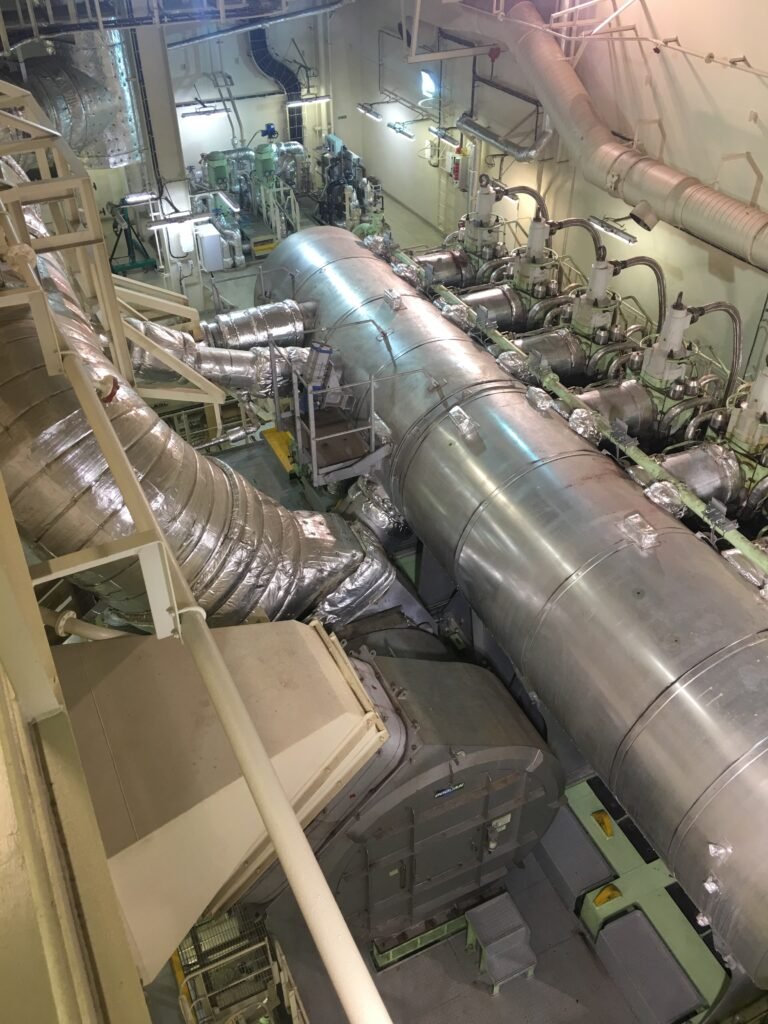understanding the turbocharger in slow-speed marine engines
The turbocharger is a fundamental component in modern slow-speed marine engines, playing a critical role in enhancing efficiency and performance. This article explores the purpose, operation, and working of turbochargers in slow-speed marine engines, with insights into designs from leading manufacturers like MAN B&W, Sulzer, Wärtsilä, and Mitsubishi Heavy Industries.

Purpose of the Turbocharger
Turbochargers serve several vital functions in marine engines:
- Improving Efficiency: By utilizing exhaust gases to compress the intake air, turbochargers significantly enhance the overall efficiency of the engine. This process increases the air density entering the combustion chamber, allowing more fuel to be burned efficiently and thereby improving power output without increasing engine size.
- Boosting Power Output: Turbochargers enable engines to produce more power by forcing more air into the cylinders. This increased air volume allows for a greater amount of fuel to be injected and combusted, resulting in higher power output and better performance.
- Reducing Fuel Consumption: Enhanced air compression leads to better combustion efficiency, which helps in reducing specific fuel consumption. This translates into significant cost savings and is particularly beneficial for large marine vessels that consume vast amounts of fuel.
- Lowering Emissions: Efficient combustion not only boosts performance but also reduces harmful emissions. By optimizing the air-fuel mixture, turbochargers help minimize the release of pollutants such as nitrogen oxides (NOx) and particulate matter, contributing to cleaner and more environmentally friendly engine operation.
Operation of the Turbocharger
The operation of a turbocharger in a slow-speed marine engine involves several key steps:
- Exhaust Gas Collection: As the engine operates, exhaust gases produced from the combustion process are expelled from the cylinders and directed towards the turbocharger.
- Driving the Turbine: The high-pressure exhaust gases enter the turbine side of the turbocharger. As these gases flow through the turbine blades, they cause the turbine to spin at very high speeds. This rotational energy is then transferred to the compressor side via a common shaft.
- Compressing Intake Air: On the compressor side, the spinning turbine drives the compressor wheel. This wheel draws in ambient air and compresses it, significantly increasing the air pressure and density before it enters the engine’s intake manifold.
- Boosting Engine Power: The compressed air is then fed into the engine’s cylinders during the intake stroke. This dense air allows for more fuel to be burned efficiently, resulting in a higher power output and improved engine performance.
Working Mechanism of the Turbocharger
The detailed working mechanism of a turbocharger in a slow-speed marine engine can be broken down into several technical aspects:
- Design and Construction: Turbochargers are robustly constructed from materials capable of withstanding extreme temperatures and pressures. Key components include the turbine housing, compressor housing, rotating assembly (including the turbine and compressor wheels), and bearings.
- Turbine Side: The turbine housing is designed to channel exhaust gases efficiently through the turbine wheel. The shape and size of the turbine blades are optimized for maximum energy extraction from the exhaust gases. The turbine wheel is usually made from high-temperature resistant materials such as Inconel.
- Compressor Side: The compressor housing contains the compressor wheel, which draws in and compresses the intake air. The design of the compressor blades is crucial for achieving high compression ratios and efficient airflow. Compressor wheels are often made from lightweight, high-strength materials like aluminum or titanium alloys.
- Bearing System: The rotating assembly is supported by a bearing system, which minimizes friction and ensures smooth operation at high rotational speeds. Bearings are typically either journal bearings or ball bearings, each offering different advantages in terms of durability and performance.
- Cooling and Lubrication: Turbochargers operate under extreme conditions, requiring effective cooling and lubrication systems. Oil from the engine lubricates the bearings and helps dissipate heat. Additionally, water-cooled housings may be used to further manage temperatures and maintain the longevity of the turbocharger.
Leading Manufacturers: MAN B&W, Sulzer, Wärtsilä, and Mitsubishi Heavy Industries
Several prominent manufacturers have made significant contributions to the design and efficiency of turbochargers in slow-speed marine engines:
- MAN B&W: Known for their innovative engineering, MAN B&W turbochargers are designed to optimize engine performance and efficiency. They incorporate advanced materials and aerodynamic designs to enhance air compression and minimize energy losses. MAN B&W turbochargers are recognized for their durability and reliability in harsh marine environments.
- Sulzer: Sulzer’s turbochargers are renowned for their robust construction and high efficiency. They focus on delivering consistent performance with minimal maintenance requirements. Sulzer’s designs often incorporate features that enhance the aerodynamic efficiency of the compressor and turbine stages, resulting in superior performance and fuel savings.
- Wärtsilä: A leading global player in marine and energy markets, Wärtsilä designs turbochargers that are highly efficient and reliable. Their turbochargers are known for their durability and performance, incorporating the latest technological advancements to ensure optimal engine function.
- Mitsubishi Heavy Industries: Mitsubishi designs turbochargers that are durable and efficient, focusing on maximizing the performance of their marine engines. Their designs are known for robustness and reliability in demanding marine environments.
The History and Invention of the Turbocharger
The concept of turbocharging dates back to the early 20th century, with the invention attributed to Swiss engineer Alfred Büchi. In 1905, Büchi patented the first turbocharger, which aimed to increase an engine’s power output by using exhaust gases to drive a compressor, thereby forcing more air into the combustion chamber. This innovation laid the groundwork for modern turbocharging technology.
Conclusion
The turbocharger is a critical component in slow-speed marine engines, significantly enhancing efficiency, power output, and environmental performance. Understanding its operation and working mechanism is essential for both amateur enthusiasts and experienced marine engineers. Leading manufacturers like MAN B&W, Sulzer, Wärtsilä, and Mitsubishi Heavy Industries continue to advance turbocharger technology, driving the marine industry towards greater efficiency and sustainability.





